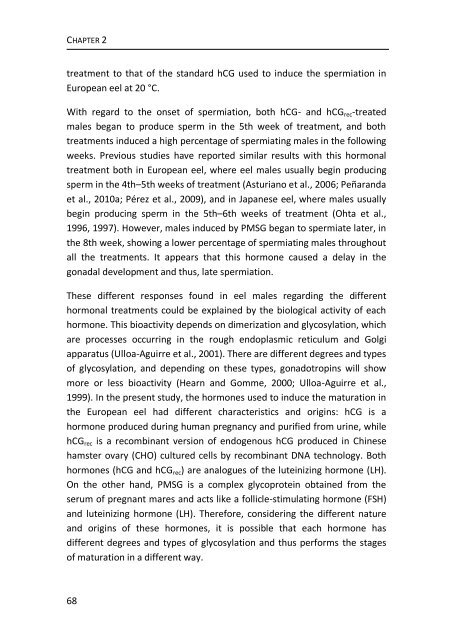chapter 3 - RiuNet
chapter 3 - RiuNet
chapter 3 - RiuNet
You also want an ePaper? Increase the reach of your titles
YUMPU automatically turns print PDFs into web optimized ePapers that Google loves.
CHAPTER 2<br />
treatment to that of the standard hCG used to induce the spermiation in<br />
European eel at 20 °C.<br />
With regard to the onset of spermiation, both hCG- and hCG rec -treated<br />
males began to produce sperm in the 5th week of treatment, and both<br />
treatments induced a high percentage of spermiating males in the following<br />
weeks. Previous studies have reported similar results with this hormonal<br />
treatment both in European eel, where eel males usually begin producing<br />
sperm in the 4th–5th weeks of treatment (Asturiano et al., 2006; Peñaranda<br />
et al., 2010a; Pérez et al., 2009), and in Japanese eel, where males usually<br />
begin producing sperm in the 5th–6th weeks of treatment (Ohta et al.,<br />
1996, 1997). However, males induced by PMSG began to spermiate later, in<br />
the 8th week, showing a lower percentage of spermiating males throughout<br />
all the treatments. It appears that this hormone caused a delay in the<br />
gonadal development and thus, late spermiation.<br />
These different responses found in eel males regarding the different<br />
hormonal treatments could be explained by the biological activity of each<br />
hormone. This bioactivity depends on dimerization and glycosylation, which<br />
are processes occurring in the rough endoplasmic reticulum and Golgi<br />
apparatus (Ulloa-Aguirre et al., 2001). There are different degrees and types<br />
of glycosylation, and depending on these types, gonadotropins will show<br />
more or less bioactivity (Hearn and Gomme, 2000; Ulloa-Aguirre et al.,<br />
1999). In the present study, the hormones used to induce the maturation in<br />
the European eel had different characteristics and origins: hCG is a<br />
hormone produced during human pregnancy and purified from urine, while<br />
hCG rec is a recombinant version of endogenous hCG produced in Chinese<br />
hamster ovary (CHO) cultured cells by recombinant DNA technology. Both<br />
hormones (hCG and hCG rec ) are analogues of the luteinizing hormone (LH).<br />
On the other hand, PMSG is a complex glycoprotein obtained from the<br />
serum of pregnant mares and acts like a follicle-stimulating hormone (FSH)<br />
and luteinizing hormone (LH). Therefore, considering the different nature<br />
and origins of these hormones, it is possible that each hormone has<br />
different degrees and types of glycosylation and thus performs the stages<br />
of maturation in a different way.<br />
68
















